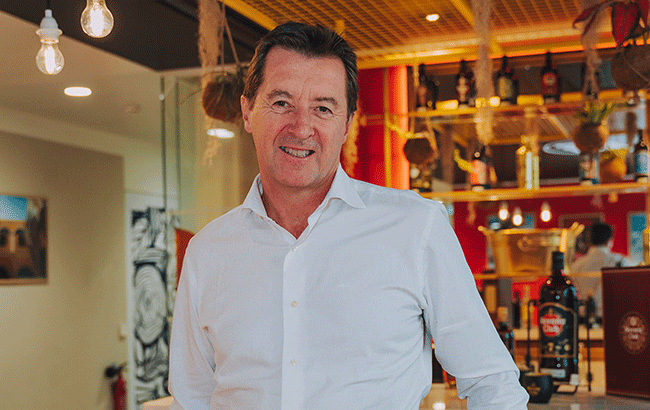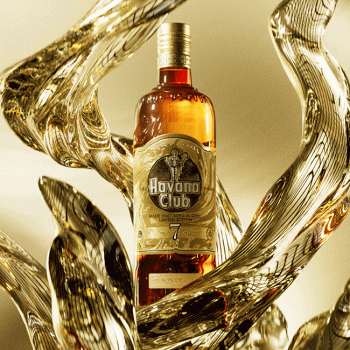Havana Club CEO: ‘US is 35% of world rum market’
Rising costs and supply chain woes have posed challenges across the rum category. We meet Havana Club International CEO Christian Barré to discuss the US-Cuba trade embargo, rum regulations, premiumisation and the importance of the on-trade.

Havana Club CEO Christian Barré has much to be pleased about. When parent company Pernod Ricard unveiled its 2022/23 full-year financial results in August this year, Havana Club was celebrating 6% growth.
It’s a notable feat – and is arguably only scratching the surface of the Cuban rum brand’s full potential, given its inability to trade in the US due to the long-running Cuba-US embargo. It’s a big chunk of the rum market, too, as Barré explains: “The US is 35% of the world rum market. So we only have access to 65% of the world market.”
The trade embargo was put in place following Fidel Castro’s 1959 revolution. In November this year, the UN General Assembly made its 31st call for the US to end its trade embargo against Cuba, a non-binding resolution that was approved by 187 countries and opposed only by the US and Israel, with Ukraine abstaining.
There is little to no indication of when the embargo will be lifted, but Barré is hopeful it is a case of ‘when’, not ‘if’.
“It will take years,” he says. “On the business part, what we need to do is prepare Havana Club to be sold in the US market the day the embargo is lifted. We have a seven-year-old rum, a 15-year-old rum, so we need to plan well in advance because what we are putting in our casks today might not be ready until 2030 or 2031 if it’s seven years old. And every year, we will adjust our plan according to our forecasts.”
Havana Club trademark dispute
Havana Club has been embroiled in a long-running legal dispute with Bacardi over the ‘Havana’ trademark in the US for years. The Havana Club brand was originally established by José Arechabala in 1934. Post-Prohibition in 1953, the trademark was registered in Cuba. However, the US Havana Club trademark expired in 1973.
The following year, CubaExport applied for the registration of the Havana Club trademark with the US Patent and Trademark Office (USPTO), which was approved in 1976. Then in 1993, Pernod Ricard and Coporación Cuba Ron established the Havana Club International joint venture.
In 1995, Bacardi raised its first complaint against the trademark, and asked the USPTO to cancel the trademark registered by CubaExport in the US, claiming ownership of the trademark.
There have been more developments in recent years, as Bacardi filed a new lawsuit in December 2021 against the USPTO in the Virginia District Court seeking cancellation of the trademark renewal. In April 2022, the court dismissed the lawsuit. Bacardi moved to appeal this motion; in March this year, the DC Court granted in part and denied in part CubaExport’s motion to dismiss the appeal, and denied the motion for partial summary of judgement.
On 19 April, CubaExport filed a counterclaim for infringement of its Havana Club trademark, which was met on 19 May with a motion filed by Bacardi asking the DC Court to dismiss CubaExport’s counterclaim. The next step will see DC Court decide on Bacardi’s request to dismiss CubaExport’s counterclaim.
“We will see in the coming months [what the judge says], but what we do believe is that we have absolutely all the elements and we keep working with the judge to make sure that we demonstrate all the legitimacy that there is behind this,” Barré adds.

Looking to Havana Club’s best-performing markets, and Barré notes the brand’s export success in Western Europe. “We are very strong in Germany, being our number one export market, and France, number two,” Barré adds. He also notes the UK, Italy, Spain and Belgium as important markets where the brand has “a very strong presence”.
“One of the strategic objectives that we have is to expand our geographic footprint in new territories and new markets,” he adds. “If I take the example of Mexico, Canada, Poland, and I could also mention Turkey, these are markets that 10/15 years ago were not that important for the brand but now they are starting to be quite important. Mexico for example, this year will be the number one or number two export market for Havana Club Seven Years Old, very close to Spain – so it’s quite interesting to see the development of the brand in Mexico, and especially the development of the seven-year-old.” These markets, he says, are short- or mid-term markets.
Then there are places where the strategy will be more long term, he explains. “For example, we just launched Havana Club in India and in Korea. So, India is a massive market, huge market,” he says. India’s alcohol market is still dominated by local brands, but this is where Barré sees a key opportunity for a brand like Havana Club. “We believe in coming to a market [like India] with a more premium proposal [because] you have 10% of the population being middle and upper class – but 10% of 1.4 billion people is twice the size of the UK or twice the size of France, that’s a massive group of people,” he says. “And China too – but it will take time.”
Havana club is committed to positioning itself as a premium rum offering – and Barré appears unfazed about the impact rising costs could have on the premiumisation trend being seen across the category.
“Premiumisation is a very important strategic pillar,” he says. “Costs are going up, but I think we have to look at the bigger situation. What we saw was this explosion of the market, of inflation post-Covid; transportation costs, cardboard costs, everything went up. But now, what we are seeing is all these increases have started to slow down, or even slightly, slightly started to decrease. So what we can expect is products in this situation will flatten, and we will probably have less pressure on that front in the future. This is our expectation.”
On-trade importance
The brand is also committed to supporting and growing its presence in the on-trade – and Barré is proud of the brand’s activities in the sector. In November, Havana Club unveiled a new cocktail competition centred around teamwork, called Havana Club Cocktail Maestros. The stakes are high with a €10,000 (US$10,700) prize and a trip to Havana, Cuba, up for grabs for the winning team.
“As a brand, traditionally Havana Club has always been doing cool things with the on-trade because we’ve really built the brand through the trade,” Barré says. “In fact, if you compare the average weight of our sales in the on-trade compared to other rum or spirit brands, normally we always over-index in the on-trade because traditionally we’ve done a great job in the trade. It is a key strategic focus for us.
“Our Cocktail Maestros competition shows the importance of the on-trade and the fact that we do believe that the on-trade is absolutely key in building brands. We believe with this concept, we are addressing a need in terms of support for the trade, in terms of training and also communicating the values of the brand; these are probably your first ambassadors.”
Asked about his thoughts on creating cross-category regulations to ascertain a global rum standard, Barré says “in an ideal world, it would be great”. However: “The reality is that it’s going to be very hard to put together around the table because rum’s so diversified.” This latter point is also what makes the rum category such an exciting spirit to work with for Barré.
“The fact that we don’t have strict rules that apply to everyone – and while it would be much easier for consumers if the frame could be made a bit clearer – it stimulates creativity, not just for Havana Club, but from other producers as well which is a positive.”
Related news
Inside the ‘spiritual home’ of Scotch
